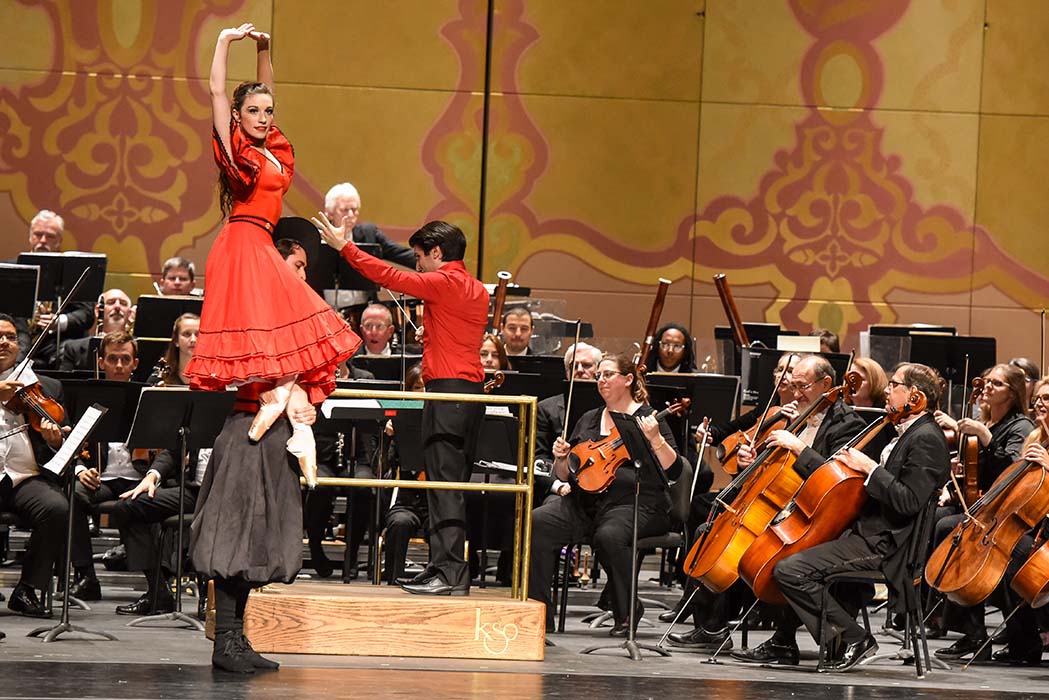Every symphony concert is like a bubbling cauldron of ingredients, a mixture of music, performers, and performances that takes on a dynamic life of its own. Add or remove one ingredient, or alter the mixture’s balance, and something new emerges. Factor in behind-the-scenes intangibles and the mood and expectations of the audience and the result becomes an unpredictable—but hopefully brilliant—concoction.
That bubbling cauldron that was the Knoxville Symphony Orchestra’s Masterworks concerts this weekend, entitled “Red, Hot, & Bolero,” produced some very tasty surprises in a sensationally rewarding experience. At first glance, the program of South American, Mexican, and Spanish-themed works may have seemed a bit one-sided to a lot of concertgoers, even within the context of dance as an underpinning and the headline attraction of Ravel’s always-popular Boléro. As it turned out, Maestro Aram Demirjian could not have picked a better program to showcase the orchestra’s individual players, just at a time when the KSO musicians are seeking a well-deserved visibility—and making their case in contract negotiations with their management.
Working to dismiss any false impressions of a one-flavor concert, Demirjian gave the ‘before’ and ‘after intermission’ segments of the program notably distinct qualities. Closing out the first half was Alberto Ginastera’s suite of Four Dances from the ballet Estancia. The ballet itself, written in 1941 but never performed until 1952, was originally a commission from Lincoln Kirstein for his Ballet Caravan in plans that never materialized. Demirjian’s added ingredient here was to invite choreographer Amy Morton Vaughn and 12 members of her Appalachian Ballet Company to the apron of the Tennessee Theatre to return the sense of sparkle, movement, and color to the four sections that already drip with the rhythmic textures of Argentinian country life. The second movement, “Wheat Dance,” was a luscious pas de deux of sorts with soloist-dancers David Tlaiye and Laura Morton. The final movement, “Malambo,” exploded with energy, fast pace, and driving rhythm, in a dance derived from a traditional competition among Argentinian gauchos.

The concert overflowed with notable solo moments for orchestra members from the very beginning. That beginning was the addictive and satisfying Danzón No. 2 by the contemporary Mexican composer, Arturo Márquez. (Savvy television viewers may have caught a hint of the work in Amazon’s Mozart in the Jungle.) The performance featured marvelous solos by clarinetist Gary Sperl; oboist Claire Chenette; the KSO’s new principal keyboardist, Zachary Hughes; violinist and concertmaster William Shaub; principal trumpet Phillip Chase Hawkins, and piccolo, Cynthia D’Andrea.
Although Thomas Adès is not Spanish, nor was the subject matter of his opera Powder Her Face, his suite derived from the opera used the subtext of dance to administer the story. The suite expands the instrumentation from a small 15-player ensemble to full orchestra proportions, heavy on the woodwinds—again a feast for the KSO players.
In short, the opera tells a somewhat fictionalized version of the divorce of Margaret Campbell, Duchess of Argyll, who was raised in socialite circles of New York City and whose sexual exploits in London became public during the 1960s divorce proceedings. The acerbic Overture evokes the tango described in instrumental laughter mocking the Duchess and her sexual decadence. The second movement is a waltz with a dreamy, hazy center that drifts between disconcerting tonalities. The finale ends with a sad abruptness.
The bubbling concert cauldron introduced a work to this reviewer. It was Gerónimo Giménez’ Intermezzo from his zarzuela [an operetta-like form mixing music and spoken dialog], La Boda de Luis Alonso. Again, addictive, complex rhythms and luscious instrumental textures invaded the ear and enticed the brain.
One concert surprise—and for the wrong reasons—came from the most familiar of pieces on the concert, parts of the Carmen Suites No. 1 and No. 2 of George Bizet. Oddly, perhaps because of this familiarity and the overwhelming amount of other musical spice on the program, the performance of the Bizet seemed to lack the focus, dynamic pacing, and rhythmic punctuation that one expects.
However, there was nothing lacking in the evening’s performance of Maurice Ravel’s Boléro.
Originally written by Ravel as a ballet for a dancer-friend, Ida Rubenstein, a woman dances seductively on a Spanish inn table, slowing arousing her own passion and that of the men around her. In the concert hall, however, the work has become a showcase piece for orchestral players that draws the admiring audience inexorably into the gradual crescendo and the layers of provocative instrumental textures that are heaped one upon the other. After the unflagging rhythm from the snare drum and the tension of dynamics has built to an unsustainable level, the key change to E major is like a sudden awakening, only to be climaxed by a wave of dissonance, then a soul-relieving resolution.
Here again, the KSO solo players made their case in no uncertain terms: snare drummer Clark Harrell (later doubled by Andrew Adzima); flutists Hannah Hammel and Jill Bartine; clarinetist Gary Sperl; bassoonist Aaron Apaza; and Claire Chenette on the oboe d’amore—and augmented by a host of additional musicians.
This concert and its themes provoked another revelation. Knoxville’s surging and revitalized arts and music scene has unfortunately seemed to leave behind the most vulnerable of art forms—dance and ballet. The presence of Appalachian Ballet Company on this occasion reminded us that we’ve had to settle, for the most part, for dance companies appearing as guests of others. Isn’t it time for a major Knoxville dance presence to come out of the wings and take the stage on its own?





